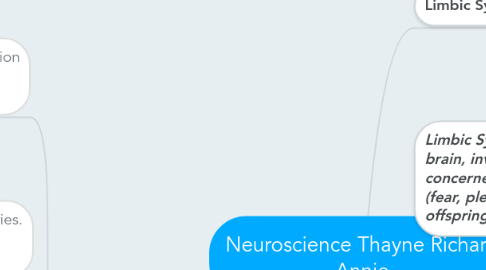
1. LOBES of the Cerebral Cortex
1.1. Frontal Lobe - executive decision making. Cognitive Process. Planning/engaging.
1.1.1. Frontal Lobe (LEFT) - Speech control, expressive speech, memory for verbal info.
1.1.2. Frontal Lobe (RIGHT) - Visual Memory
1.2. Temporal Lobe - Shot/Long Term memories. Processes sensory input. Language Comprehension. Emotional Responses.
1.2.1. Temporal Lobe (LEFT) - understanding speech analysis, reading and writing, verbal memory, letter recognition
1.2.2. Temporal Lobe (RIGHT) - Decoding, nonverbal patterns, visual decoding, interpreting and remembering visual info.
1.3. Occipital Lobe - Vision/ Perception
1.3.1. Occipital Lobe (LEFT) - object and visual recognition, reading numbers and letters, memory for written info.
1.3.2. Occipital Lobe (RIGHT) - Attending to Left visual fuild
1.4. Parietal Lobe - sensory location. touch (pain & temp) ability to draw, reading, writing and calculations.
1.4.1. Parietal Lobe (LEFT) - Smooth speech, writing skills, understanding math, reading skills, naming objects, verbal memory
1.4.2. Parietal Lobe (RIGHT) - drawing skills
2. Limbic System: complex system of nerves and networks in the brain, involving several areas near the edge of the cortex concerned with instinct and mood. It controls the basic emotions (fear, pleasure, anger) and drives (hunger, sex, dominance, care of offspring).
3. Limbic System
3.1. amygdala
3.1.1. known as the emotional center of the brain
3.2. hippocampus
3.2.1. essential role in the formation of new memories about past expierences
3.3. thalamus
3.3.1. associated with the change in emotional reactivity
3.4. hypothalamus
3.4.1. sensory way station
4. Neurotransmitters
4.1. Oxytocin
4.1.1. Comparisons between social attachment processes and drug addiction
4.1.1.1. The neuropeptides oxytocin and vasopressin are hypothesized to integrate social information into attachment processes that is not present in drug addiction. Conclusions: Social attachment may be understood as a behavioral addiction
4.2. Dopamine
4.2.1. Study about dopamine transporters (DAT) recovery after methamphetamine detoxification
4.2.1.1. Methamphetamine abusers who remained abstinent nine-months later (n = 9) showed significant increases in DAT (20%)
